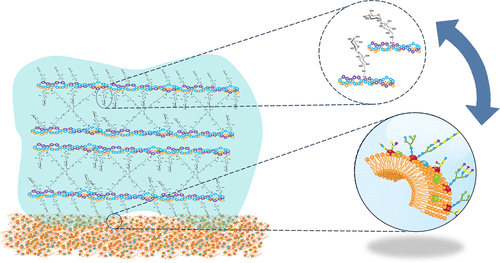当前位置:
X-MOL 学术
›
Biomacromolecules
›
论文详情
Our official English website, www.x-mol.net, welcomes your
feedback! (Note: you will need to create a separate account there.)
Glycan-Functionalized Collagen Hydrogels Modulate the Glycoenvironment of a Neuronal Primary Culture.
Biomacromolecules ( IF 5.5 ) Pub Date : 2020-05-20 , DOI: 10.1021/acs.biomac.0c00387 Ana Lúcia Rebelo 1 , Joëlle Bizeau 1 , Laura Russo 2 , Abhay Pandit 1
Biomacromolecules ( IF 5.5 ) Pub Date : 2020-05-20 , DOI: 10.1021/acs.biomac.0c00387 Ana Lúcia Rebelo 1 , Joëlle Bizeau 1 , Laura Russo 2 , Abhay Pandit 1
Affiliation

|
Glycans play a central role in the development and homeostasis of the central nervous system (CNS), so changes in the glycosylation profile of the cell surface and extracellular matrix (ECM) components are evident in CNS disorders. Regenerative medicine-based strategies using biomaterial platforms are being increasingly used to target these diseases and to study the glyco-signature of the physiological and pathological conditions, particularly through the use of biomaterials able to recapitulate natural components and physical organization of the ECM. Collagen hydrogels have shown potential as a vehicle for the delivery of cells into the brain, and their therapeutic effect can be expanded by functionalizing them to address the glycosylation patterns altered with specific brain disorders. The goal of this study is to develop and optimize a glycan-functionalized tridimensional collagen-based hydrogel that will make contact with and modulate the differentiation of a primary neuronal culture. The developed system would provide more information on how a glyco-engineered material can influence the native glyco-signature profile during the process of cell differentiation by a differential modulation of glycan expression at the tissue level. To this purpose, collagen polymers underwent one step reductive amination with maltose (Glc(α1-4)α-Glc) and lactose (Gal(β1-4)β-Glc) so that the pyranosidic structure of the reducing sugar could be sacrificed (acting as a linker) and the α-Glc and β-Gal residues exposed, respectively. The glycoconjugate biopolymers were used to formulate hydrogels that were chemically and biologically characterized, and the glyco-signature profile of a neuronal culture after hydrogel treatment was analyzed by lectin staining. The hydrogel conjugated with glucose limited the astrocytic proliferation for up to 2 weeks and promoted the increase in sialylation while decreasing fucosylation by 2-fold. These results indicate the differential influence of glycan residues present in the matrix on cellular sugar expression and thus have potential to enhance cell delivery systems in the central nervous system.
中文翻译:

聚糖功能化胶原蛋白水凝胶调节神经元原代培养物的糖环境。
聚糖在中枢神经系统(CNS)的发育和体内平衡中起着核心作用,因此在CNS疾病中,细胞表面糖基化分布和细胞外基质(ECM)成分的变化很明显。使用生物材料平台的基于再生医学的策略正越来越多地用于针对这些疾病并研究生理和病理状况的糖信号,特别是通过使用能够概括ECM天然成分和物理组织的生物材料。胶原蛋白水凝胶已显示出将细胞输送到大脑的潜力,可以通过功能化胶原蛋白水凝胶来解决因特定脑部疾病而改变的糖基化模式,从而扩大其治疗效果。这项研究的目的是开发和优化基于聚糖功能化的三维胶原蛋白的水凝胶,该凝胶将与原代神经元培养物接触并调节其分化。开发的系统将提供有关糖工程材料如何通过组织水平上聚糖表达的差异调节在细胞分化过程中如何影响天然糖特征谱的更多信息。为此,胶原蛋白聚合物用麦芽糖(Glc(α1-4)α-Glc)和乳糖(Gal(β1-4)β-Glc)进行了一步还原胺化,因此可以牺牲还原糖的吡喃硅酸结构(充当连接子),并分别暴露出α-Glc和β-Gal残基。糖缀合物生物聚合物用于配制具有化学和生物学特性的水凝胶,并通过凝集素染色分析了水凝胶处理后神经元培养物的糖签名特征。与葡萄糖结合的水凝胶限制了星形胶质细胞的增殖长达2周,并促进了唾液酸化的增加,同时使岩藻糖基化降低了2倍。这些结果表明基质中存在的聚糖残基对细胞糖表达的不同影响,因此具有增强中枢神经系统中细胞递送系统的潜力。
更新日期:2020-07-13
中文翻译:

聚糖功能化胶原蛋白水凝胶调节神经元原代培养物的糖环境。
聚糖在中枢神经系统(CNS)的发育和体内平衡中起着核心作用,因此在CNS疾病中,细胞表面糖基化分布和细胞外基质(ECM)成分的变化很明显。使用生物材料平台的基于再生医学的策略正越来越多地用于针对这些疾病并研究生理和病理状况的糖信号,特别是通过使用能够概括ECM天然成分和物理组织的生物材料。胶原蛋白水凝胶已显示出将细胞输送到大脑的潜力,可以通过功能化胶原蛋白水凝胶来解决因特定脑部疾病而改变的糖基化模式,从而扩大其治疗效果。这项研究的目的是开发和优化基于聚糖功能化的三维胶原蛋白的水凝胶,该凝胶将与原代神经元培养物接触并调节其分化。开发的系统将提供有关糖工程材料如何通过组织水平上聚糖表达的差异调节在细胞分化过程中如何影响天然糖特征谱的更多信息。为此,胶原蛋白聚合物用麦芽糖(Glc(α1-4)α-Glc)和乳糖(Gal(β1-4)β-Glc)进行了一步还原胺化,因此可以牺牲还原糖的吡喃硅酸结构(充当连接子),并分别暴露出α-Glc和β-Gal残基。糖缀合物生物聚合物用于配制具有化学和生物学特性的水凝胶,并通过凝集素染色分析了水凝胶处理后神经元培养物的糖签名特征。与葡萄糖结合的水凝胶限制了星形胶质细胞的增殖长达2周,并促进了唾液酸化的增加,同时使岩藻糖基化降低了2倍。这些结果表明基质中存在的聚糖残基对细胞糖表达的不同影响,因此具有增强中枢神经系统中细胞递送系统的潜力。











































 京公网安备 11010802027423号
京公网安备 11010802027423号